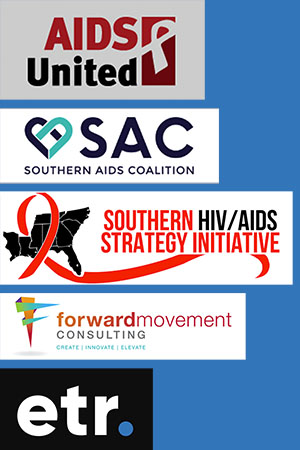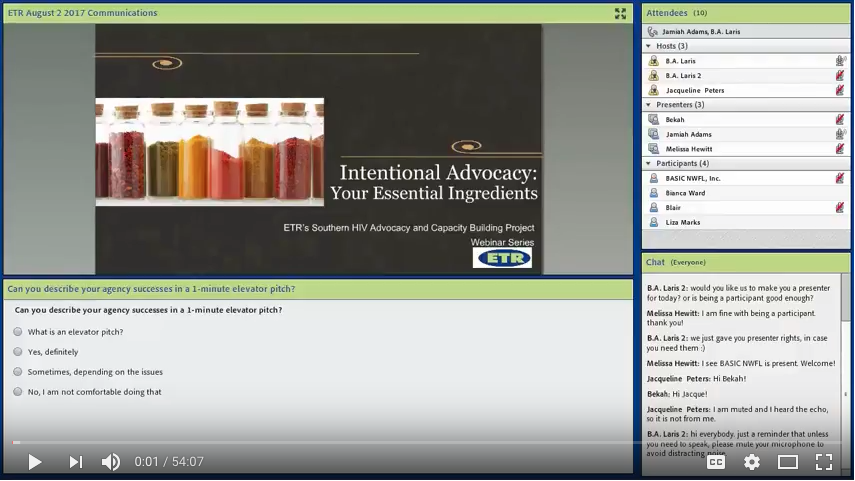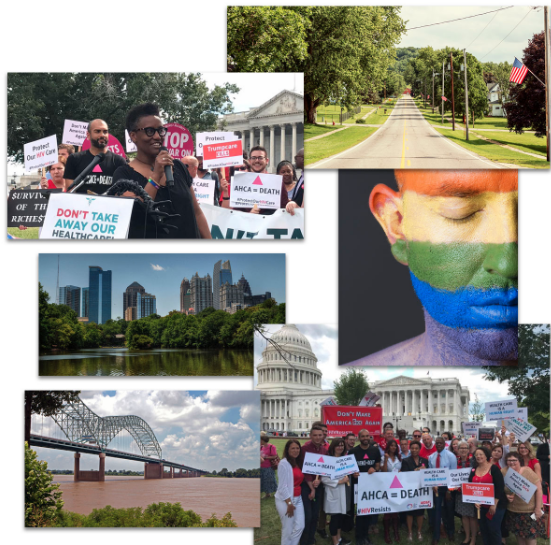Intentional Advocacy in the South: Success Starts with Trust and Community
By Michael Everett, MHS | May 22, 2018
Advocacy is an extraordinary and powerful tool. This is a strategy that can tailor itself to the unique needs and culture of any service-related organization. It’s also genuinely exciting to offer technical assistance to organizations interested in putting advocacy to work.
These are just some of the reasons ETR’s team embraces any opportunity we are given to support organizations in building advocacy skills and practices.
When organizations bring a thoughtful and informed process to building advocacy efforts, we call this “intentional advocacy.” This is not a boilerplate method. Properly done, the decisions and outcomes of intentional advocacy cannot be the same for all organizations. Instead, each organization must determine what sorts of advocacy efforts will best answer their specific needs and interests.
Examples in Practice
Part 2 of this post shares the examples of two organizations who put Intentional Advocacy to work in completely different ways, achieving the best outcomes for their particular needs. See it here.
A Bold Plan for Intentional Advocacy
We are excited to have received support from Gilead Sciences for the Intentional Advocacy (IA) project. The project supports their commitment to the sustainability of community-based organizations (CBO’s). The goal is to invigorate HIV-focused CBO’s in the South through advocacy and capacity-building.
Why? Because advocacy goes hand-in-hand with HIV prevention and treatment interventions. It is the belief of the IA project that advocacy can change the landscape of HIV and AIDS in the South.

The American South has a fierce need for this kind of attention in HIV prevention and treatment efforts. It is a region with a high incidence of HIV, high AIDS diagnoses, high death rates, a high level of stigma and few resources. The practice of intentional advocacy offers a pathway to leverage Southern wisdom and experience in ways that resonate authentically for residents and can make a genuine difference in prevention, treatment and availability of services.
An Impressive Group of Partners
Our goal with the Intentional Advocacy project was to prepare members of the Southern HIV/AIDS prevention and care workforce for advocacy-specific strategic positioning. What would work in their organization? How could they have the greatest impact in their community? What did they need to sustain their organization in these times of budget cutbacks and diminishing attention to HIV?
IA worked intensively with six organizations on individualized capacity-building plans. At the same time, we worked to improve their strategic communications and enhance their advocacy efforts at local, state and—where appropriate—national levels.

AIDS United, Southern AIDS Coalition, Southern HIV/AIDS Strategy Initiative, and Forward Movement Consulting partnered with ETR in selecting and supporting the following organizations for the first cohort. Here are the organizations, and a summary of the work we did with them through the project.
- Abounding Prosperity (TX). Developed a communications and marketing plan that will allow the agency to attract more allies and potential partners for sexual health and HIV-related advocacy work in the South.
- Atlanta Harm Reduction Coalition (GA). Bridged harm reduction expertise with priorities of new MSM funding in Atlanta to serve as a model to other MSM-serving institutions in the Atlanta area. (“MSM” is “males who have sex with males.”)
- BASIC NWFL (FL). Moved beyond local partnerships to support board and staff’s role in developing advocacy strategies in marketing, promotion and regional partnerships.
- NAESM (GA). Rebranded and repackaged current services to attract potential advocacy partners.
- Us Helping Us (DC). Refined a communications plan to support advocacy goals during leadership transition.
- W.O.M.E.N. (TN). Developed a plan to prioritize fund development to position the agency to meet advocacy goals.
This was a year-long process. Cohort members participated in a range of activities in order to advance advocacy goals and improve accountability systems.
Building Trust and Mutual Commitment
Advocacy can be done by an individual, or by individual organizations. But it is most powerful when practiced across a broader community, such as multiple organizations with a shared focus. We wanted the six participating organizations to engage with one another in support, learning, encouragement, motivation and problem-solving. We hoped they would inspire one another and collaborate to build unique and powerful advocacy activities.
Toward that end, the IA project arranged a series of interventions.
Memphis: Convening
In May 2017, ETR hosted a convening engaging all of the cohort organizations in Memphis TN. This event ensured that the cohort organizations understood the project’s expectations. Even more importantly, it offered the opportunity for the groups to understand one another better, and to build trust and mutual commitment.
Agency Capacity-Building Plan
At the convening, each cohort organization participated in a critical process of collaboration. They expressed what they needed—their vision for their organization and their community. Then they worked with organizational development experts to apply best practices to their goals.

Webinar Series
ETR developed a 5-part webinar series designed to increase capacities around advocacy, self-care, marketing and communications. These are free and open to anyone interested in learning more about the practice of Intentional Advocacy. You can find them at ETR’s Community Impact Solutions webpage, or click on the links below.
- Intentional Advocacy Webinar: Your Essential Ingredients Part 1
- Intentional Advocacy Webinar: Your Essential Ingredients Part 2
- Intentional Advocacy Webinar: Your Essential Ingredients Part 3
- Intentional Advocacy Webinar: Your Essential Ingredients Part 4
- Intentional Advocacy Webinar: Your Essential Ingredients Part 5
In-Person Technical Assistance (TA)
Technical assistance was critical to building capacities of individual organizations. We were able to use tailored trainings to address the unique needs of all cohort members. We offered trainings on Marketing Evaluation & Communications, Funding Development, Board Development, and more.
As a result of these offerings, all of the cohort members have found some success in moving toward their advocacy goals. In Part 2 of this post, I’ll share more about the successes of two of the organizations. These case studies will offer a sense of the rich diversity of possibility when organizations are given support to tailor their advocacy efforts to their own needs and cultures.
Free e-Learning Course: “A Jewel of a Resource”
One of true jewels that has come out of the Intentional Advocacy project is the self-paced e-learning course Advocacy in the South. The course is a collaboration between The Southern AIDS Coalition and ETR. It supports grassroots advocacy in the South, so it has a particularly Southern focus. However, I believe the lessons it offers will be relevant to any client-service organization, whatever its focus and wherever it operates. Anyone can access the course.

The course demonstrates some of the ways that advocacy goes hand-in-hand with HIV prevention and treatment interventions. It addresses topics such as:
- The power of advocacy for Southern organizations
- Ways to incorporate advocacy to strengthen the work organizations are already doing
- A tool to assess an organization’s capacity to engage in advocacy
- Access to specific strategies that can be used in a particular setting
Empowering and Transformative
It is inspiring to engage in such powerful work with these determined and resourceful organizations. I watch their tenacity and grit with wonder. They never stop fighting for their clients, even in this climate where resources are few, and low-income people with HIV are among the first to be ignored.
It is also empowering to see the ways intentional advocacy can leverage the strengths and creativity of the individuals who make up these organizations. It reinforces my belief in the vitality of this approach. I encourage you to check out some of the resources that have emerged from this project and consider the ways these strategies might strengthen your own organization’s work.
Michael Everett, MHS, is a Project Director at ETR.




